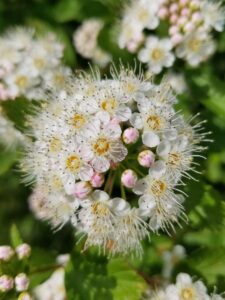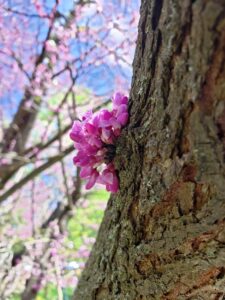Throughout the decades, many landscape fads have ended in failure. Dame’s rocket, wintercreeper, and purple loosestrife are a few examples of beautiful and vigorous ornamentals that have wreaked havoc on our natural ecosystems. Nursery professionals, as well as consumers, were unaware of the potential negative impacts of non-native species, often marketed as vigorous, hardy, or sterile. These species have been so detrimental to the environment, they are now illegal to sell, gift, or introduce in Indiana and more plants are expected to be added to this list of banned species1.
Thanks to efforts like the National Invasive Species Awareness Week (NISAW)2, more consumers are requesting native species, but they may not know where to begin or may have HOA guidelines to comply with. Callery pear (Pyrus calleryana) and burning bush (Euonymus alatus) have both been found to invade Indiana woodlands and yet are still commonly found in the home landscape.
Common ninebark (Physocarpus opulifolius) is a native replacement for burning bush that provides even better year-round interest (Photo 1). This fast-growing shrub makes an excellent hedge while providing a valuable nectar source for native pollinators.
- Photo 1. Ninebark flower clusters turn to red seed capsules that persist into the winter. Photo credit: Ashley Adair
- Photo 2. Eastern redbud flowers form clusters on the branches and trunk. Photo credit: Karen Mitchell
If you’re looking for an early blooming tree, instead of callery pear, try Eastern redbud (Cercis canadensis). This native tree provides nectar early in the season for pollinators when food is otherwise scare (Photo 2) and avoids the invasive nature and other problems of callery pear, such as fire blight disease and breaking in wind storms.
Plant for our future. Native species can fulfill our need for a beautiful landscape while providing food and shelter for pollinators and birds. Every yard, easement, and ditch has the potential to either help or hurt our environment. As more individuals recognize this, we are seeing a paradigm shift away from the desire for a pristine landscape to a landscape that is a part of the natural ecosystem.
More information about replacing invasive plants can be found:
ID-464-W Alternative Options for Invasive Landscape Plants: https://www.extension.purdue.edu/extmedia/ID/ID-464-W.pdf
Indiana Native Plant Society:
https://indiananativeplants.org/landscaping/landscape-uses-of-native-plants/
State of Indiana Cooperative Invasive s Management:
https://www.sicim.info/landscaping-with-native-plants
References:
- https://www.in.gov/dnr/rules-and-regulations/invasive-species/terrestrial-invasive-species-plants/
- https://www.nisaw.org/nisaw-2022/

